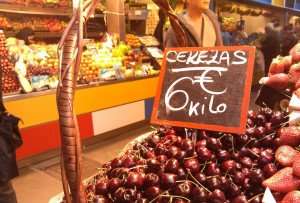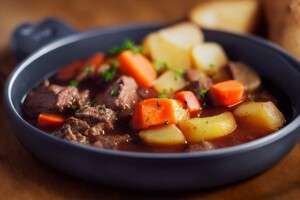Top Four Reasons to Travel to Bordeaux!
December 6, 2024
Bordeaux is well known for being the wine capital of the world, and with good reason. Bordeaux produces at least 400 million liters of -…
Read This Post Spain has always been a paradise for the gastronomic enthusiast, and seafood lovers will know that Malaga is a can’t-miss destination for the foodie in your life! This sunny city in Andalusia is home to a number of unmatched culinary delights that will leave you wanting more. Malaga is famous for its seafood due to its proximity to the sea, and you can enjoy a variety of dishes unique to the region.
Spain has always been a paradise for the gastronomic enthusiast, and seafood lovers will know that Malaga is a can’t-miss destination for the foodie in your life! This sunny city in Andalusia is home to a number of unmatched culinary delights that will leave you wanting more. Malaga is famous for its seafood due to its proximity to the sea, and you can enjoy a variety of dishes unique to the region.
 Malaga is famous for its sweet fortified wine of the same name, which traditionally comes in a white variety. Sierra de Malaga wine is also produced in the region and can come in red, white, or rosé varieties. Demand for sweet wines had dropped for most of the 20th century, but there has been a rise in popularity recently that is breathing new life into the wine industry in Malaga. Most of their wine is made in the towns of Frigiliana and Velez, and Pedro Ximenez and Moscatel are the only grape varietals used in Malaga wine.
Malaga is famous for its sweet fortified wine of the same name, which traditionally comes in a white variety. Sierra de Malaga wine is also produced in the region and can come in red, white, or rosé varieties. Demand for sweet wines had dropped for most of the 20th century, but there has been a rise in popularity recently that is breathing new life into the wine industry in Malaga. Most of their wine is made in the towns of Frigiliana and Velez, and Pedro Ximenez and Moscatel are the only grape varietals used in Malaga wine.
Read our article about Spanish sweet wines and sherry!
Malaga’s raisins, or Pasas de Malaga, are a protected regional output, and made exclusively from muscat grapes. These grapes were brought to Spain by invading Muslims about 300 years ago and are now used for winemaking, dessert, and, of course, raisins. Since Malaga’s raisins have a protected status, certain production requirements must be met in order for producers to market them as Pasas de Malaga. The grapes cannot be bruised or damaged, and they can never touch the ground. These raisins are also made using exclusively natural sunlight rather than an oven.
 In addition to these gastronomic outputs, Malaga has plenty of excellent restaurants and culinary traditions to explore. Other key ingredients in the gastronomy of Malaga include eggplants and almonds, which are featured prominently in side dishes and snacks. Street vendors sell a popular dish, almendras fritas, which are almonds coated in sea salt and olive oil and then fried. Eggplant is often similarly sliced and fried, then drizzled with cane honey for a delicious marriage of sweet and savory flavors. And, although there are plenty of foods more particular to the region, you would be remiss not to try the paella. Paella in Malaga is especially delicious, and it is known for being one of the most flavorful iterations of the dish that you can find in Spain.
In addition to these gastronomic outputs, Malaga has plenty of excellent restaurants and culinary traditions to explore. Other key ingredients in the gastronomy of Malaga include eggplants and almonds, which are featured prominently in side dishes and snacks. Street vendors sell a popular dish, almendras fritas, which are almonds coated in sea salt and olive oil and then fried. Eggplant is often similarly sliced and fried, then drizzled with cane honey for a delicious marriage of sweet and savory flavors. And, although there are plenty of foods more particular to the region, you would be remiss not to try the paella. Paella in Malaga is especially delicious, and it is known for being one of the most flavorful iterations of the dish that you can find in Spain.
Find out the Top 3 Things to See in Andalusia!
Anchovies represent a cornerstone of Malaga’s cuisine, and can be found primarily in different types of tapas. They are usually prepared in one of two ways; either fried or pickled in vinegar, water, and salt. However, the high season for anchovies occurs in spring and summer, so one may want to stick to the pickled variety in autumn and winter.
Today we are sharing our top five favorite dishes to eat in Malaga, but rest assured, you will never find yourself at a loss for delicious new food during your travels.
 1. Campero Malagueño
1. Campero MalagueñoSpain is well-known for its sandwiches due to the country’s strong disposition for cured meats and cheeses, but we recommend you make a point of trying this one. A popular lunch dish in Malaga, the Campero Malagueño became popular around 1950, with the rise of sandwich and burger shops around Spain. These shops became popular amongst schoolchildren and workers who did not take the traditional 2-3 hour lunch break.
The Campero Malagueño is unique to the city of Malaga, and the sandwich is made up of a few key ingredients, which can be modified to your heart’s desire. You will find that the most important component of this sandwich is the bread, which is called Mollete de Antequera. These round buns or rolls have a muffin-like texture despite their savory flavor. The bun is sliced in half before adding lettuce, tomato, mayonnaise, cooked or cured ham, grilled chicken, and sliced cheese of your choice. The sandwich can be served cold, but is traditionally grilled.
Can’t get enough Spanish food? Try these 5 Tips for Making the Perfect Paella!
 2. Espeto
2. EspetoThis beloved local dish of sardines skewered on a stick and roasted over an open fire (preferably right on the beach!) can be traced back about 200 years to the Malaga neighborhood of El Palo. El Palo translates to “the stick,” and the town is known for its relaxed atmosphere and beautiful beaches. The anchovies are roasted on rods made of long pieces of sugarcane, which have been cut to about 2o inches and split in half lengthwise. One must skewer the anchovies with great care, avoiding the spine while ensuring the fish are all placed evenly on the rod. The best way to achieve this is to arrange your anchovies so that the largest are at the bottom and the smallest at the top.
Salt and lemon juice are all the seasoning one needs for a delicious espeto, and should be liberally applied to the fish before cooking. Ensuring that your espeto does not burn can be a challenge, and keeping the anchovies on ice until the last possible moment is the key to cooking this dish successfully. You will want to keep the skewer upwind of the fire and roast it for no more than five minutes on each side.
 3. El Pescaito Frito
3. El Pescaito FritoThis simple, fried mixed seafood dish can be found at just about every restaurant in Malaga, and you almost certainly will not be able to resist ordering it more than once. El Pescaito Frito can be traced all the way back to the third century BC, and by the 16th century it was a traditional Shabbat dish for the Andalusian Jews. It is believed that this dish originated the practice of flouring and frying fish, and that the method was copied to create the popular British dish of Fish and Chips.
To make Pescaito Frito, the fish must be cleaned and dried before being salted and coated in flour, then fried in olive oil until crispy. The seafood selection in any Pescaito Frito dish can vary depending on the catch of the day, however there are usually anchovies, calamari, and hake to be found on your plate.
 4. Porra Antequerana
4. Porra AntequeranaThis chilled soup is similar to a classic gazpacho, but even richer and creamier than the original. The addition of stale or day-old bread thickens the soup for a slightly heavier meal, so the dish is usually served as tapas rather than as an appetizer. Though this soup has the same tomato and garlic base as gazpacho, it is made with green peppers rather than onion and cucumber, and it is usually topped with ham, tuna, and boiled eggs. Like other gazpacho variations, Porra Antequerana is traditionally made using a mortar and pestle to pound the ingredients together, though nowadays most people use a food processor or blender. The mortar and pestle method is still sometimes employed if one wants a less silky consistency or to avoid foam.
Check out this recipe for Andalusian Gazpacho and try it for yourself.
Malaga is also famous for another chilled soup, called Ajoblanca, which is made with almonds as its base rather than tomatoes. This dish is occasionally referred to as “White Gazpacho,” since the ingredients and preparation differ only slightly from the classic chilled soup. The creamy white soup has a distinct nutty flavor, though the preparation and cooking process is almost identical to Porra Antequerana. In nearby Granada the soup is usually served accompanied by a baked potato, but in Malaga it is always garnished with grapes or another fresh fruit such as melon or apple.
Are you all about almonds? Try this delectable Spanish recipe for Cod in Almond Sauce!
 5. “Robo de Toro” or Ronda Style Oxtail Stew
5. “Robo de Toro” or Ronda Style Oxtail StewThis delicious and hearty stew is a staple winter dish in Malaga and especially in the Ronda area, where bullfighting has been a traditional practice for hundreds of years. Variations of this dish have been served following bull fights since Roman times, and the hearty stew has remained popular ever since. Originally, the tails of the dead and defeated oxen were gathered following the tournament and used to make dinner for the following evening.
The rich and flavorful oxtail is combined with red wine and vegetables before slow cooking for several hours. This method of cooking is necessary to soften the tough meat of the oxtail, but when done correctly you will find it is unmatched in taste and quality. The recipe usually includes veggies such as carrots, leeks, bell pepper, and onion, but can be modified to include what you have on hand. The important ingredients are olive oil, garlic, and red wine with salt, pepper, and parsley to taste.
Check out our Southern Spain Food and Wine Tour of Málaga and Ronda!
Malaga is rich in history and immersed in a cultural identity unique to not only the region but the city itself. A stay in Malaga is guaranteed to include memorable meals and adventures, no matter what. There are many other delicious local specialties to enjoy, such as the peasant soup, Gazpachuelo, made from egg yolks, mayonnaise, potatoes, fish, and soup stock. The delicious hearty dishes of the working class encompass the core tenets of gastronomy in the region, featuring simple but fresh and quality ingredients meant to nourish.
There isn’t a bad time of year to visit Malaga, but the food you try during your stay might change depending on the season. Chilled soups are a popular light meal in summertime, though El Pescaito Frito is available year round in this city by the sea. No matter the menu, Malaga is an excellent destination for food lovers everywhere.
Browse all our cooking vacations in Spain.
Sign up to receive our newsletter, which includes travel tips, recipes, promotions, and information on our best cooking vacations.
Find more photos, videos, food facts, and travel stories from The International Kitchen on Facebook, Instagram, and YouTube.